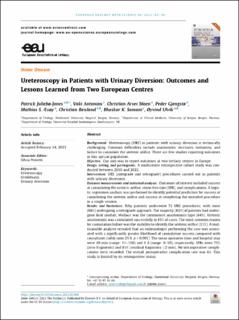| dc.contributor.author | Jones, Charles Patrick W. | |
| dc.contributor.author | Antoniou, Vaki | |
| dc.contributor.author | Moen, Christian Arvei | |
| dc.contributor.author | Gjengstø, Peder | |
| dc.contributor.author | Æsøy, Mathias S. | |
| dc.contributor.author | Beisland, Christian | |
| dc.contributor.author | Somani, Bhaskar K. | |
| dc.contributor.author | Ulvik, Øyvind | |
| dc.date.accessioned | 2024-02-14T14:04:50Z | |
| dc.date.available | 2024-02-14T14:04:50Z | |
| dc.date.created | 2023-06-16T10:13:30Z | |
| dc.date.issued | 2023 | |
| dc.identifier.issn | 2666-1691 | |
| dc.identifier.uri | https://hdl.handle.net/11250/3117613 | |
| dc.description.abstract | Background: Ureteroscopy (URS) in patients with urinary diversion is technically challenging. Common difficulties include anastomotic strictures, tortuosity, and failure to cannulate the ureteric orifice. There are few studies reporting outcomes in this special population.
Objective: Our aim was to report outcomes at two tertiary centres in Europe.
Design, setting, and participants: A multicentre retrospective cohort study was conducted between 2010 and 2022.
Intervention: URS (antegrade and retrograde) procedures carried out in patients with urinary diversions.
Outcome measurements and statistical analysis: Outcomes of interest included success at cannulating the ureteric orifice, stone-free rate (SFR), and complications. A logistic regression analysis was performed to identify potential predictors for success at cannulating the ureteric orifice and success at completing the intended procedure in a single session.
Results and limitations: Fifty patients underwent 72 URS procedures, with most (86%) undergoing a retrograde approach. The majority (82%) of patients had undergone ileal conduit. Wallace was the commonest anastomosis type (64%). Ureteric anastomosis was cannulated successfully in 81% of cases. The most common reason for cannulation failure was the inability to identify the ureteric orifice (11%). A multivariable analysis revealed that an endourologist performing the case was associated with a significantly greater likelihood of cannulation success compared with consultants (odds ratio 25.9, p < 0.001). The mean operative time and hospital stay were 49 min (range: 11–126) and 1 d (range: 0–10), respectively. SFRs were 75% (zero fragments) and 81% (residual fragments ≤2 mm). No intraoperative complications were recorded. The overall postoperative complication rate was 6%. This study is limited by its retrospective status.
Conclusions: Endourological experience increases the likelihood of successful ureteric cannulation and procedural success. A low complication rate can be achieved despite this being a population with often multiple comorbidities. | en_US |
| dc.language.iso | eng | en_US |
| dc.publisher | Elsevier | en_US |
| dc.rights | Navngivelse 4.0 Internasjonal | * |
| dc.rights.uri | http://creativecommons.org/licenses/by/4.0/deed.no | * |
| dc.title | Ureteroscopy in Patients with Urinary Diversion: Outcomes and Lessons Learned from Two European Centres | en_US |
| dc.type | Journal article | en_US |
| dc.type | Peer reviewed | en_US |
| dc.description.version | publishedVersion | en_US |
| dc.rights.holder | Copyright 2023 the authors | en_US |
| cristin.ispublished | true | |
| cristin.fulltext | original | |
| cristin.qualitycode | 1 | |
| dc.identifier.doi | 10.1016/j.euros.2023.02.008 | |
| dc.identifier.cristin | 2155186 | |
| dc.source.journal | European Urology Open Science | en_US |
| dc.source.pagenumber | 85-90 | en_US |
| dc.identifier.citation | European Urology Open Science. 2023, 50, 85-90. | en_US |
| dc.source.volume | 50 | en_US |

